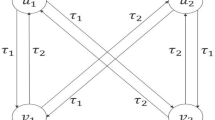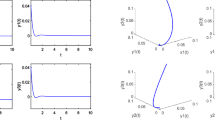Abstract
In this paper, a fractional model of a special structure of bidirectional associative memory (BAM) neural networks called tri-diagonal BAM neural networks (TdBAMNNs) is considered. The Hopf bifurcation analysis is made for the proposed fractional system in the presence of leakage and communication delays. The feasibility of the obtained theoretical results is verified by numerical simulations.



















Similar content being viewed by others
Data Availability
Not applicable.
References
Ahmed E, El-Sayed AMA, El-Saka HAA (2006) On some Routh-Hurwitz conditions for fractional order differential equations and their applications in Lorenz, Rössler, Chua and Chen systems. Phys Lett A 358:1–4. https://doi.org/10.1016/j.physleta.2006.04.087
Ali MS, Narayanan G, Sevgen S, Shekher V, Arik S (2019) Global stability analysis of fractional-order fuzzy BAM neural networks with time delay and impulsive effects. Commun Nonlinear Sci Numer Simul. https://doi.org/10.1016/j.cnsns.2019.104853
Alzabut J, Swati T, Abbas S (2020) Discrete fractional-order BAM neural networks with leakage delay: existence and stability results. Asian J Cont 22(1):1–13. https://doi.org/10.1002/asjc.1918
Huang C, Cao JD (2017) Impact of leakage delay on bifurcation in high-order fractional BAM neural networks. Neural Netw. https://doi.org/10.1016/j.neunet.2017.11.020
Huang C, Liu H, Chen Y, Chen X, Song F (2021) Dynamics of a fractional-order BAM neural network with leakage delay and communication delay. Fractals 29(3):2150073. https://doi.org/10.1142/S0218348X21500730
Huang C, Liu H, Shi X, Chen X, Xiao M, Wang Z, Cao JD (2020) Bifurcations in a fractional-order neural network with multiple leakage delays. Neural Netw 131:115–126. https://doi.org/10.1016/j.neunet.2020.07.015
Huang C, Meng Y, Cao JD, Alsaedi A, Alsaadi FE (2017) New bifurcation results for fractional BAM neural network with leakage delay. Chaos Solitons Fractals 100:31–44. https://doi.org/10.1016/j.chaos.2017.04.037
Huang C, Wang J, Chen X, Cao JD (2021) Bifurcations in in a fractional-order BAM neural network with four different delays. Neural Netw 141:344–354. https://doi.org/10.1016/j.neunet.2021.04.005
Lin J, Xu R, Li LC (2019) Effect of leakage delay on Hopf bifurcation in a fractional BAM neural network. Int J Bifurcat Chaos 29(6):1950077. https://doi.org/10.1142/S0218127419500779
Podlubny I (1999) Fractional differential equations. Academic Press, New York
Wang F, Yang Y, Xu X, Li L (2017) Global asymptotic stability of impulsive fractional-order BAM neural networks with time delay. Neural Comput Appl 28:345–352. https://doi.org/10.1007/s00521-015-2063-0
Wang N, Xu C, Liu Z (2021) Further exploration on bifurcation for fractional-order bidirectional associative memory (BAM) neural networks concerning time delay. Complexity 2021:9096727. https://doi.org/10.1155/2021/9096727
Wang T, Cheng Z, Bu R, Ma R (2018) Stability and Hopf bifurcation analysis of a simplified six-neuron tridiagonal two-layer neural network model with delays. Neurocomputing. https://doi.org/10.1016/j.neucom.2018.12.005
Wang T, Wang Y, Cheng Z (2021) Stability and Hopf bifurcation analysis of a general tri-diagonal BAM neural network with delays. Neural Process Lett 53:4571–4592. https://doi.org/10.1007/s11063-021-10613-8
Xu C, Alhejaili W, Saifullah S, Khan A, Khan J, El-Shorbagy MA (2022) Analysis of Huanglongbing disease model with a novel fractional piecewise approach. Chaos Solitons Fractals 161:112316. https://doi.org/10.1016/j.chaos.2022.112316
Xu C, Aouiti C, Liu Z (2020) A further study on bifurcation for fractional order BAM neural networks with multiple delays. Neurocomputing 417:501–515. https://doi.org/10.1016/j.neucom.2020.08.047
Xu C, Liao M, Li P, Guo Y, Liu Z (2021) Bifurcation properties for fractional order delayed BAM neural networks. Cogn Comput 13:322–356. https://doi.org/10.1007/s12559-020-09782-w
Xu C, Liao M, Li P, Yan J (2019) Influence of time delay on bifurcation in fractional order BAM neural networks with four delays. IEEE Access 7:70955–70965. https://doi.org/10.1109/ACCESS.2019.2919979
Xu C, Liao M, Li P, Yao L, Qin Q, Shang Y (2021) Chaos control for a fractional-order jerk system via time-delay feedback controller and mixed controller. Fractal fract 5:257. https://doi.org/10.3390/fractalfract5040257
Xu C, Liu Z, Liao M, Li P, Xiao Q, Yuan S (2021) Fractional-order bidirectional associate memory (BAM) neural networks with multiple delays: The case of Hopf bifurcation. Math Comput Simul 182:471–494. https://doi.org/10.1016/j.matcom.2020.11.023
Xu C, Mu D, Liu Z, Pang Y, Liao M, Aouiti C (2023) New insight into bifurcation of fractional-order 4D neural networks incorporating two different time delays. Commun Nonlinear Sci Numer Simul 118:107043. https://doi.org/10.1016/j.cnsns.2022.107043
Xu C, Mu D, Liu Z, Pang Y, Liao M, Li P, Yao L, Qin Q (2022) Comparative exploration on bifurcation behavior for integer-order and fractional-order delayed BAM neural networks. Nonlinear Anal: Model Control 27:1030-1053. https://doi.org/10.15388/namc.2022.27.28491
Xu C, Rahman M ur, Baleanu D (2022) On fractional-order symmetric oscillator with offsetboosting control. Nonlinear Anal: Model Control 27:994-1008. https://doi.org/10.15388/namc.2022.27.28279
Xu C, Zhang W, Aouiti C, Liu Z, Yao L (2023) Bifurcation insight for a fractional-order stage-structured predator–rey system incorporating mixed time delays. Math Methods Appl Sci 46. https://doi.org/10.1002/mma.9041
Yang X, Song Q, Liu Y, Zhao Z (2014) Uniform stability analysis of fractional-order BAM neural networks with delays in the leakage terms. Abstr Appl Anal 2014:261930. https://doi.org/10.1155/2014/261930
Zhang H, Ye R, Cao JD, Alsaedi A (2017) Existence and globally asymptotic stability of equilibrium solution for fractional-order hybrid BAM neural networks with distributed delays and impulses. Complexity 2017:6875874. https://doi.org/10.1155/2017/6875874
Author information
Authors and Affiliations
Contributions
The authors equally contributed to the study by designing the problem, conceptualization, methodology, and investigation. The first author drafted the manuscript with numerical simulations. Supervision, review, and editing were done by the second author. Both authors read and approved the final manuscript.
Corresponding author
Ethics declarations
Conflict of interest
The authors declare that they have no competing interests.
Ethical Approval
Not applicable.
Additional information
Publisher's Note
Springer Nature remains neutral with regard to jurisdictional claims in published maps and institutional affiliations.
Appendix 1
Appendix 1
Proof of Theorem 3.1:
Let \(\sigma = 0\). The characteristic equation Eq. (4) can be reduced into
Substituting \(r^{2\omega } = \gamma \) in Eq. (14), we have
where \( \alpha _{i} \) are the coefficients of \( \gamma ^{i} \) (i = 0,1,2,...,n-1).
The Routh-Hurwitz matrices for 2n-neuron FODTdBAMNNs system (2) is defined as follows.
Let us assume \( \Delta _i > 0\) \( (i = 1,2,...,n)\).
Then by fractional Routh-Hurwitz conjecture [1], all the roots \(\gamma _i\) of Eq. (15) have the absolute value of its argument greater than \(\frac{\omega \pi }{2} \) for \(i = 1,2,...,n\). So, by Lemma 2.1, we can conclude that the FODTdBAMNNs system (2) is asymptotically stable when \(\sigma = 0\). Also, since Eq. (10) has no positive real roots, we can conclude that FODTdBAMNNs system (2) is asymptotically stable in the global sense for \(\sigma \in \left[ 0, \infty \right) \).
This completes the validation. \(\square \)
Proof of Theorem 3.2:
Let \(r(\sigma ) = \mu (\sigma ) + i \nu (\sigma )\) be the root of the Eq. (3) near \(\sigma = \sigma _j\) satisfying \( \mu (\sigma _j) = 0 \) and \( \nu (\sigma _j) = 0 \).
Differentiate Eq. (3) with respect to \(\sigma \), we obtain
Thus, we have
where
Therefore,
When \(\sigma = \sigma _0\) and \(\nu = \nu _0\), let \( P(r) = P_1 + i P_2 \) and \( Q(r) = Q_1 + i Q_2 \). Then, we have
Hence by the assumption \( (\mathcal {A}_2 )\), one can get
where \( P_1,\) \( P_2,\) \( Q_1\) and \(Q_2 \) are obtained as follows.
As Eq. (10) has at least one positive real root, we can come to the conclusion that the stability of the zero equilibrium of the FODTdBAMNNs system (2) is asymptotic in the local sense for \(\sigma \in \left[ 0, \sigma _0 \right) \) and Hopf bifurcation occurs at the origin when \(\sigma = \sigma _0\). \(\square \)
Rights and permissions
Springer Nature or its licensor (e.g. a society or other partner) holds exclusive rights to this article under a publishing agreement with the author(s) or other rightsholder(s); author self-archiving of the accepted manuscript version of this article is solely governed by the terms of such publishing agreement and applicable law.
About this article
Cite this article
Rakshana, M., Balasubramaniam, P. Hopf Bifurcation of General Fractional Delayed TdBAM Neural Networks. Neural Process Lett 55, 8095–8113 (2023). https://doi.org/10.1007/s11063-023-11302-4
Accepted:
Published:
Issue Date:
DOI: https://doi.org/10.1007/s11063-023-11302-4
Keywords
- Fractional order derivative
- Stability
- Hopf bifurcation
- Tri-diagonal BAM neural network
- Leakage delay
- Communication delay




